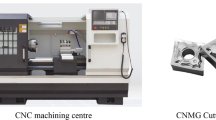Abstract
The nickel-based superalloy, CM247 is machined using wire electro spark material removal process with three different levels of process parameters. The material removal rate and the surface finish are evaluated individually to assess the influence of process parameters. Maximum material removal is noticed with increase in pulse on duration and superior surface finish with average pulse on time. At 30 V and 120 μs in pulse on time, maximum material removal is noticed and better surface roughness as 2.211 μm. The machinability of the material depends on the duration of electro spark intensity generated during machining. Pulse on time has a maximum influence (53%) on surface roughness followed by the applied voltage (30%). In material removal, the applied voltage (87%) is a predominant factor. A modified genetic algorithm, mimic of iconic pair Adam and Eve is simulated to study the varying populations. From the optimization technique, a globally best process parameter is identified for the electro spark material removal of CM247 alloy. The optimal process condition is 18 V and 126 µs for applied voltage and pulse on time.








Similar content being viewed by others
Data availability
Data sharing not applicable to this article as no datasets were generated or analyzed during the current study.
References
Abbas AT, Sharma N, Anwar S, Luqman M, Tomaz I, Hegab H (2020) Multi-response optimization in high-speed machining of Ti-6Al-4V using TOPSIS-fuzzy integrated approach. Materials 13:1104
Adam Khan M, Winowlin Jappes J T, P.S.Samuel Ratna Kumar, Peter Madindwa Mashinini (2020) Machining parameter optimization using Adam gene algorithm for electro spark erosion on shape memory alloy, Materials Today Proceedings, 46(Part 17) 2021: 7487-7491
Adam Khan M, Jani SP, Senthil Kumar A, Rajesh S (2021) Machining parameter optimization using Adam—Gene Algorithm while turning lightweight composite using ceramic cutting tools, Int J Lightweight Mater Manufacture
Adam Khan M, Gupta K (2020) On heat treatment and surface characterization of spark eroded nickel-based superalloy developed by additive manufacturing. Trans Indian Inst Metals 73:429–439
Alfattani R, Yunus M, Selvarajan L, Venkataramanan K (2023) Spark erosion behavior in the machining of MoSi2–SiC ceramic composites for improving dimensional accuracy, J Mech Behav Biomed Mater 148
Anush Raj B, Winowlin Jappes JT, Adam Khan M, Dillibabu V, Brintha NC (2020) Direct Metal Laser Sintered (DMLS) process to develop Inconel 718 alloy for turbine engine components. Optik, 2020
Chakraborty S, Chakraborty S (2022) A sco** review on the applications of MCDM techniques for parametric optimization of machining processes. Arch Computat Methods Eng
Grigoriev SN, Volosova MA, Fedorov SV, Okunkova AA, Pivkin PM, Peretyagin PY, Ershov A (2021) Development of DLC-coated solid SiAlON/TiN ceramic end mills for nickel alloy machining: problems and prospects. Coatings 11:532
Hardy MC, Detrois M, McDevitt ET (2020) Solving recent challenges for wrought Ni-base superalloys. Metall Mater Trans A 51:2626–2650
Jeyaprakash N, Yang CH (2020) Improvement of tribo-mechanical properties of directionally solidified CM-247 LC nickel-based superalloy through laser material processing. Int J Adv Manuf Technol 106:4805–4814
Ogunbiyi O, Jamiru T, Sadiku R, Beneke L, Adesina O, Obadele BA (2020) Corrosion and wear behaviour of spark plasma-sintered NiCrCoAlTiW-Ta Superalloy. J Bio- Tribo-Corrosion 6:1
Ouyang G (2017) High temperature structure materials beyond nickel base superalloy. J Mater Sci Nanomater 1(2):107–112
Pusavec F, Deshpande A, Yang S, M'Saoubi R, Kopac J, Wlliam DillonJr O, Jawahir IS (2015) Sustainable machining of high temperature Nickel alloy—Inconel 718: part 2—chip breakability and optimization, J Clean Prod 87: 941 – 952.
Raj BA, Winowlin Jappes JT, Adam Khan M, Dillibabu V, Brintha NC (2021) Solid particle erosion studies on heat treated SU718 alloy developed through DMLS processed additive manufacturing. Adv Mater Sci Eng
Selvarajan L, Venkataramanan K (2023) Surface morphology and drilled hole accuracy of conductive ceramic composites Si3N4–TiN and MoSi2–SiC on EDMed surfaces. Wear 530–531:204973
Selvarajan L, Venkataramanan K, Nair A et al (2023a) Enhanced Jaya optimization in electrical discharge hole making of MoSi2–SiC composite with surface morphology analysis. J Braz Soc Mech Sci Eng 45:555. https://doi.org/10.1007/s40430-023-04493-3
Selvarajan L, Rajavel R, Yunus M, Alfattani R (2023b) Die-sinking and rotary EDM surface and subsurface analysis of MoSi2-SiC ceramic composites. Mater Sci Technol 39(18):3150–3166
Singh JB (2022) Introduction. In: Alloy 625. Materials horizons: from nature to nanomaterials. Springer, Singapore
Trung DD (2021) Application of EDAS, MARCOS, TOPSIS, MOORA and PIV methods for multi-criteria decision making in milling process, J Mech Eng 71: 69 – 84
Yu J, Wang Y, Zhao X, Li Q, Qiao Q, Zhao J, Zhai S (2019) Wear Resistance of Ni-Based Alloy Coatings. Adv Mater Sci Eng
Author information
Authors and Affiliations
Contributions
Stalin - Drafted the manuscript with experimentation Adam - Developed the problem statement and methodology Winowlin - Supported in Data inference and findings Brintha - Supported in tuning the manuscript
Corresponding author
Ethics declarations
Conflict of interest
There is no conflict of Interest among authors and the content submitted for consideration.
Additional information
Publisher's Note
Springer Nature remains neutral with regard to jurisdictional claims in published maps and institutional affiliations.
Rights and permissions
Springer Nature or its licensor (e.g. a society or other partner) holds exclusive rights to this article under a publishing agreement with the author(s) or other rightsholder(s); author self-archiving of the accepted manuscript version of this article is solely governed by the terms of such publishing agreement and applicable law.
About this article
Cite this article
Stalin, S.R., Khan, M.A., Jappes, J.T.W. et al. Experiment assessment and Adam gene algorithm to optimize the process parameter of wire spark erosion material removal while machining nickel alloy. Multiscale and Multidiscip. Model. Exp. and Des. (2024). https://doi.org/10.1007/s41939-023-00343-w
Received:
Accepted:
Published:
DOI: https://doi.org/10.1007/s41939-023-00343-w




